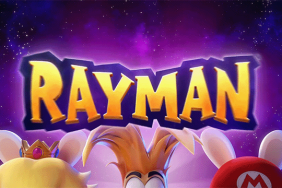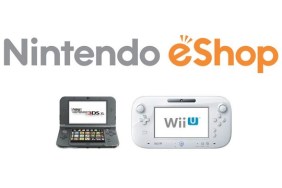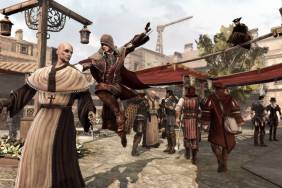Put your best kart forward.
Next to blasting Jack Thompson, our favorite GR pastime is to voraciously express our unmitigated loathing for Nintendo fanboys. Brazenly outspoken yet wildly misinformed, these fanatics undermine the essence of our very jobs by slurping up every drop of hype the company offers, paying no heed to rational concerns over quality or originality when discussing any Nintendo software, exploding into orgasmic cheer at the mere mention of Link and abjectly refusing to accept that other companies make cool games, too. We hate them the way you hate your parents, only without the love part.
But don’t for one minute think that we carry this over to Nintendo itself, because Mario have mercy, we don’t. When the big N gets it right, they are absolutely the best in the business at designing fun, accessible and, dare I say it, magical video games.
So put down your shotgun, take a nice, deep breath and join me by gazing into the ether of their latest portable addiction, the terrific Mario Kart DS. A complete package from head to toe, this is quite possibly the world’s biggest kart racer despite its diminutive size, and a few hitches notwithstanding, it’s a great game. The company, it turns out, has gotten it right.
[image1]And considering the pedigree, how couldn’t they? The Mario Kart games have consistently proven that a simple, smart gameplay formula can work time and again even if you don’t pile on a ton of stuff. This version, however, goes big by digging into its decorated past just as it peers into the hardware’s potentially bright future.
You’ll know you’ve reached the crossroads when you start exploring the game’s whopping 32 tracks. Half of those are culled from past Mario Kart games: four apiece from the legendary SNES game, the N64 outing, the GBA title and last year’s lukewarm Double Dash. They’ve all been reworked beautifully; vets will beam like idiots when racing through Donut Plains or Moo Moo Farm, shameful though the names might be. The other sixteen tracks are brand new and categorically cool, particularly the giant watches of Tick Tock Clock and the flashing mania of Waluigi Pinball. At different lengths and difficulties, the variety is great.
The maps aren’t all that’s classic – the series’ signature gameplay returns largely unchanged. You can race in 50, 100 or 150 cc matches and choose from an assortment of Nintendo mascot racers. Each has two car options, one kart and one slightly more extreme vehicle. The differences between the karts seem small but are actually quite significant, notably altering your experience from track to track. Using a fast kart with sluggish turning (Donkey Kong) will prove difficult on tracks that have no guard rails and long drops, while lighter karts (Peach) might not have the horsepower to win out on shorter, less curvy tracks. You’ll definitely find your favorites.
You’ll also take out a few enemies, as the game’s hallmark items are back as well. Standards like turtle shells, bananas and mushroom boosts are joined by three new weapons: a handy bob-omb, the ability to briefly turn into Bullet Bill for enhanced autopilot and the odd blooper squid, which obstructs your opponent’s field of vision with black ink. They’re all relatively useful, but I’m a little bummed no new defensive items were added. Other than the ability to shoot weapons from the rear, you can’t really protect yourself from incoming fire. Several of the weapons are unavoidable (especially that nasty spiked turtle) and the experience can prove frustrating when you’re out in front only to get nailed a few times by homing weapons without any chance to evade. I suppose this is meant to keep races tight, but the lack of countermeasures has been a literal pain in the butt for thirteen years. If you’re reading this, that’s probably older than you are.
[image2]Still, Mario Kart DS relies more on driving skill than weapon luck, and getting comfy with powersliding is tantamount to success. This version includes the powersliding boost mechanic from the GBA game, allowing you to gain a quick speed boost by tapping left and right on the D-Pad during a slide. The stylus is mercifully left in its holder as the game uses the bottom screen as an incredibly handy real-time map – much better than trying to switch back and forth between the D-pad and the drawing stick. With slick control despite the lack of analog functionality, it plays just as smoothly as you hoped it would.
It also plays forever thanks to the assortment of single-player modes. The standard Grand Prix lets you race through the game’s tracks in circuit fashion, while Balloon Battles and Shine Runners pit you in arena-style matches. Time Trials and VS. mode also make appearances along with the one new mode, Missions. Essentially short, timed mini-games, these function as both training tools and, at the higher levels, as moderately fun challenges. There’s simply a lot of solo gaming here.
But Mario Kart games are only worth their weight in multiplayer, and this is where Mario Kart DS truly earns its racing stripes. If everyone has a copy of the game, all-out war ensues, but up to eight local DS owners can race with just one game card, the only handicap being a limited choice of cars for non-cardholders. It’s an intelligent, effective way to strike up a fun multiplayer bout without forcing everyone to drop coin.
If local friends aren’t willing, you can always hop online, as Mario Kart DS is the very first DS game to support online Wi-Fi play. The process starts with you finding a wireless access point, which is really simple if you’re on a wireless network at home or work. If not, Nintendo will sell you one for 35 bucks, or you can embrace the world’s most heinous partnership by hanging out at one of 6,000 participating McDonald’s, who currently provide free Wi-Fi access for DS owners. The obesity? That costs money.
Instead of stuffing their fans, we wish Nintendo would have fed the online experience because it’s absurdly skinny. You can search for other players by three vague parameters (Worldwide, Regional, or Friends) and are tossed into Nintendo’s equivalent of an Optimatch for up to four players. The only stats you’ll see are your opponents’ win/loss records. There are no lobbies, no chat rooms, no rankings, and no leaderboards, just you versus a few other racers floating about the wireless world.
[image3]I suppose this opaque, archaic system was chosen to keep the process simple and friendly, but it’s also shallow when compared to pretty much any other online game out there. Simply connecting with friends is murky, as you have to first input their random 12-digit ‘Friend ID number’ instead of just searching for their handle. There’s no easy way to get someone’s number after a race, either; if you find a good opponent, good luck finding ’em again. They didn’t even bother with including some sort of Pictochat communication functionality, so don’t expect to communicate with anyone beyond the racing. Also, only twelve of the game’s tracks can be played online, as the others are disabled due to lag concerns.
But here’s the thing: when you get into a game and start powersliding against another person while, say, sitting on the toilet, all these issues sort of fade into the critical equivalent of background music. Multiplayer Mario Kart games are much better than CPU matches and this version at least offers a solution for the lonely gamer. It’s the first Mario Kart to be playable online, and despite some limitations, it works pretty well.
It also looks and sounds good. All you really want from a Mario Kart game is a steady framerate and bright colors, and you get both here. The older tracks have been gussied up nicely, while the newer ones don’t feel out of place next to the classics. The quintessential voice bytes and catchy MIDI tunes serve up typical Nintendo audio, nothing that breaks the mold.
But Mario Kart DS certainly does, even as the fifth game in a series older than many current DS owners. It goes the distance with its plentiful single-player content, provides intelligent, affordable local multiplayer and actually lets you race online. Some more work on both the user and server side of that experience would have been great, but as it stands, that adjective could be applied to this as a package. Will it turn you into a fanboy? Let’s hope not, but it will definitely turn you into a fan.
-
Smooth, classic gameplay
-
Smart use of the bottom screen
-
Tons of tracks
-
Great local multiplayer
-
Online Wi-Fi actually works
-
But could use some work, too
-
DE-fence! DE-fence!







